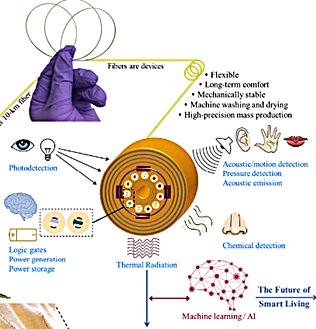
Smart Textiles Woven with Sensing, Hearing and Communication Fibres
Synopsis
This innovative wearable textile seamlessly incorporates multifunctional fibres, transforming them into smart devices. This wearable technology integrates sensing, energy conversion and various functions. The "device-in-a-fibre" can be added to garments or woven into textiles, opening up opportunities for wearable electronics, large-area sensing applications, energy generation and military use, while ensuring enhanced comfort and integration.
Opportunity
Our technology introduces a wearable textile woven with innovative fibres functioning as smart devices, seamlessly integrating multi-functional components. These fibres, known as “device-in-a-fibre”, have the potential for applications in diverse fields, especially in wearable electronics. They offer sensing and energy conversion functions, as well as desirable properties such as wearability, flexibility and air permeability.
These fibres, acting as sensors and actuators, enable the textile to “see” objects, “hear” sound, sense stimuli, communicate, store and convert energy, as well as modulate temperature and monitor health. The versatility of these fibres allows for their implementation as added smart devices onto existing textile or garment, or they can be woven into small patches or smart textiles for further applications.
Technology
Our technology represents an innovative shift in textiles through the integration of advanced functional fibres, transforming traditional textiles into fully integrated “sensing-computing-acting” wearable electronics. Using automated whole-garment digital knitting machines, functional textiles offer dense coverage (>1,000 sensors) over large complex surfaces (>6,000 cm2). These functional textiles are soft, deformable, breathable, durable and washable. The innovation extends beyond mere fabric, offering a textile-based wearable technology designed to monitor, learn, and respond to human activities, catering to the domains of smart living and healthcare.

Figure 1: Smart textiles and their applications.
Applications & Advantages
Applications:
- Wearable electronics, such as health and weight management, exercise and training management, thermal regulation and management, and active cooling, among others.
- Large-area sensing and monitoring, such as environmental sensing, including optical sensing, sound sensing, temperature sensing, pressure sensing, gas and chemical sensing.
- Energy generation from heat, motion and light.
- Military and defence applications.
Advantages:
- Improved and seamless integration of various smart functionalities into textile, garment and apparels.
- High air permeability to improve skin comfort for human use.




.tmb-listing.jpg?Culture=en&sfvrsn=3b74ec1c_1)


.tmb-listing.jpg?Culture=en&sfvrsn=414f0d90_1)







